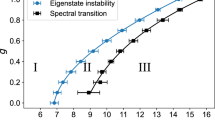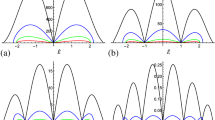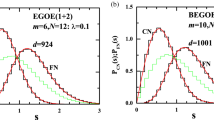Abstract
Embedded GOE generated by random two-body interactions in the presence of a one-body mean-field [called EGOE(1+2)] for spinless fermion systems is introduced and its construction follows easily from that of EGOE(2). In the limiting situation with the two-body interaction much stronger than the mean-field, EGOE(1+2) reduces to EGOE(2). Examining eigenvalue density, level fluctuations, strength functions, information and occupancy entropies as a function of the interaction strength λ (expressed in the units of the average spacing of the energies of the mean-field one-particle states), it is shown numerically that the ensemble generates three transition or chaos markers. They correspond to Poisson to GOE transition in level fluctuations, Breit-Wigner to Gaussian transition in strength functions and the third marker defining a region of thermalization. Using unitary decomposition and trace propagation on one hand and perturbation theory on the other, parametric dependence of the three chaos markers are determined. Also derived are formulas for number of principal components (NPC), information entropy and occupancy entropy.
Access this chapter
Tax calculation will be finalised at checkout
Purchases are for personal use only
Similar content being viewed by others
References
V.V. Flambaum, G.F. Gribakin, F.M. Izrailev, Correlations within eigenvectors and transition amplitudes in the two-body random interaction model. Phys. Rev. E 53, 5729–5741 (1996)
V.K.B. Kota, Embedded random matrix ensembles for complexity and chaos in finite interacting particle systems. Phys. Rep. 347, 223–288 (2001)
Y. Alhassid, Statistical theory of quantum dots. Rev. Mod. Phys. 72, 895–968 (2000)
Y. Alhassid, H.A. Weidenmüller, A. Wobst, Disordered mesoscopic systems with interaction: induced two-body ensembles and the Hartree-Fock approach. Phys. Rev. B 72, 045318 (2005)
Ph. Jacquod, D.L. Shepelyansky, Emergence of quantum chaos in finite interacting Fermi systems. Phys. Rev. Lett. 79, 1837–1840 (1997)
Ph. Jacquod, A.D. Stone, Ground state magnetization for interacting fermions in a disordered potential: kinetic energy, exchange interaction, and off-diagonal fluctuations. Phys. Rev. B 64, 214416 (2001)
M. Hamermesh, Group Theory and Its Application to Physical Problems (Addison-Wesley, New York, 1962)
B.G. Wybourne, Symmetry Principles and Atomic Spectroscopy (Wiley, New York, 1970)
F.S. Chang, J.B. French, T.H. Thio, Distribution methods for nuclear energies, level densities and excitation strengths. Ann. Phys. (N.Y.) 66, 137–188 (1971)
B.G. Wybourne, Classical Groups for Physicists (Wiley, New York, 1974)
J.C. Parikh, Group Symmetries in Nuclear Structure (Plenum, New York, 1978)
V.K.B. Kota, R.U. Haq, Spectral Distributions in Nuclei and Statistical Spectroscopy (World Scientific, Singapore, 2010)
C.M. Vincent, Group classification of many-body interactions. Phys. Rev. 163, 1044–1050 (1967)
S. Aberg, Onset of chaos in rapidly rotating nuclei. Phys. Rev. Lett. 64, 3119–3122 (1990)
R. Berkovits, Y. Avishai, Localization in Fock space: a finite-energy scaling hypothesis for many-particle excitation statistics. Phys. Rev. Lett. 80, 568–571 (1998)
N.D. Chavda, V. Potbhare, V.K.B. Kota, Statistical properties of dense interacting Boson systems with one plus two-body random matrix ensembles. Phys. Lett. A 311, 331–339 (2003)
V.K.B. Kota, R. Sahu, Breit-Wigner to Gaussian transition in strength functions, arXiv:nucl-th/0006079
B. Georgeot, D.L. Shepelyansky, Breit-Wigner width and inverse participation ratio in finite interacting Fermi systems. Phys. Rev. Lett. 79, 4365–4368 (1997)
V.V. Flambaum, F.M. Izrailev, Statistical theory of finite Fermi systems based on the structure of chaotic eigenstates. Phys. Rev. E 56, 5144–5159 (1997)
Ph. Jacquod, I. Varga, Duality between the weak and strong interaction limits of deformed fermionic two-body random ensembles. Phys. Rev. Lett. 89, 134101 (2002)
N. Frazier, B.A. Brown, V. Zelevinsky, Strength functions and spreading widths of simple shell model configurations. Phys. Rev. C 54, 1665–1674 (1996)
D. Angom, S. Ghosh, V.K.B. Kota, Strength functions, entropies and duality in weakly to strongly interacting fermion systems. Phys. Rev. E 70, 016209 (2004)
V.K.B. Kota, R. Sahu, Structure of wavefunctions in (1+2)-body random matrix ensembles. Phys. Rev. E 64, 016219 (2001)
A. Stuart, J.K. Ord, Kendall’s Advanced Theory of Statistics: Distribution Theory (Oxford University Press, New York, 1987)
L. Kaplan, T. Papenbrock, Wave function structure in two-body random matrix ensembles. Phys. Rev. Lett. 84, 4553–4556 (2000)
N.D. Chavda, V. Potbhare, V.K.B. Kota, Strength functions for interacting bosons in a mean-field with random two-body interactions. Phys. Lett. A 326, 47–54 (2004)
M. Abramowtiz, I.A. Stegun (eds.), Handbook of Mathematical Functions, NBS Applied Mathematics Series, vol. 55 (U.S. Govt. Printing Office, Washington, D.C., 1972)
J.P. Draayer, J.B. French, S.S.M. Wong, Spectral distributions and statistical spectroscopy: I General theory. Ann. Phys. (N.Y.) 106, 472–502 (1977)
V.K.B. Kota, R. Sahu, Single particle entropy in (1+2)-body random matrix ensembles. Phys. Rev. E 66, 037103 (2002)
M. Rigol, V. Dunjko, M. Olshanii, Thermalization and its mechanism for generic isolated quantum systems. Nature (London) 452, 854–858 (2008)
M. Horoi, V. Zelevinsky, B.A. Brown, Chaos vs thermalization in the nuclear shell model. Phys. Rev. Lett. 74, 5194–5197 (1995)
V.K.B. Kota, N.D. Chavda, R. Sahu, Bivariate t-distribution for transition matrix elements in Breit-Wigner to Gaussian domains of interacting particle systems. Phys. Rev. E 73, 047203 (2006)
V.K.B. Kota, R. Sahu, Information entropy and number of principal components in shell model transition strength distributions. Phys. Lett. B 429, 1–6 (1998)
J.B. French, V.K.B. Kota, A. Pandey, S. Tomsovic, Statistical properties of many-particle spectra VI. Fluctuation bounds on N-N T-noninvariance. Ann. Phys. (N.Y.) 181, 235–260 (1988)
J.P. Draayer, J.B. French, S.S.M. Wong, Spectral distributions and statistical spectroscopy: II Shell-model comparisons. Ann. Phys. (N.Y.) 106, 503–524 (1977)
J.M.G. Gómez, K. Kar, V.K.B. Kota, R.A. Molina, J. Retamosa, Number of principal components and localization length in E2 and M1 transition strengths in 46V. Phys. Rev. C 69, 057302 (2004)
Author information
Authors and Affiliations
Rights and permissions
Copyright information
© 2014 Springer International Publishing Switzerland
About this chapter
Cite this chapter
Kota, V.K.B. (2014). Random Two-Body Interactions in Presence of Mean-Field: EGOE(1+2). In: Embedded Random Matrix Ensembles in Quantum Physics. Lecture Notes in Physics, vol 884. Springer, Cham. https://doi.org/10.1007/978-3-319-04567-2_5
Download citation
DOI: https://doi.org/10.1007/978-3-319-04567-2_5
Publisher Name: Springer, Cham
Print ISBN: 978-3-319-04566-5
Online ISBN: 978-3-319-04567-2
eBook Packages: Physics and AstronomyPhysics and Astronomy (R0)




